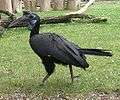Ground hornbill
The ground hornbills (Bucorvidae) are a family of the order Bucerotiformes, with a single genus Bucorvus and two extant species. The family is endemic to sub-Saharan Africa: the Abyssinian ground hornbill occurs in a belt from Senegal east to Ethiopia, and the southern ground hornbill occurs in southern and East Africa.
| Ground hornbill Temporal range: Middle Miocene to present | |
|---|---|
 | |
| Head of the male Abyssinian ground hornbill (B. abyssinicus) | |
| Scientific classification | |
| Kingdom: | Animalia |
| Phylum: | Chordata |
| Class: | Aves |
| Order: | Bucerotiformes |
| Family: | Bucorvidae Bonaparte, 1854 |
| Genus: | Bucorvus Lesson, 1830 |
| Species | |
|
Bucorvus leadbeateri | |
Ground hornbills are large, with adults around a metre tall. Both species are ground-dwelling, unlike other hornbills, and feed on insects, snakes, other birds, amphibians and even tortoises.[1] They are among the longest-lived of all birds,[2] and the larger southern species is possibly the slowest-breeding (triennially) and longest-lived of all birds.[3]
Taxonomy
The genus Bucorvus was introduced, originally as a subgenus, by the French naturalist René Lesson in 1830 with the Abyssinian ground hornbill Bucorvus abyssinicus as the type species.[4][5] The generic name is derived from the name of the genus Buceros introduced by Carl Linnaeus in 1758 for the Asian hornbills where corvus is the Latin word for a "raven".[6]
A molecular phylogenetic study published in 2013 found that the genus Bucorvus was sister to the rest of the hornbills.[7]
The genus Bucorvus contains two species:[8]
| Image | Scientific name | Common Name | Distribution |
|---|---|---|---|
 | Bucorvus abyssinicus | Abyssinian ground hornbill (also known as northern ground hornbill) | southern Mauritania, Senegal and Guinea east to Eritrea, Ethiopia, north western Somalia, north western Kenya and Uganda |
_male_(12714625605)%2C_crop.jpg) | Bucorvus leadbeateri | Southern ground hornbill | northern Namibia and Angola to northern South Africa and southern Zimbabwe to Burundi and Kenya |
A prehistoric ground hornbill, Bucorvus brailloni, has been described from fossil bones in Morocco, suggesting that prior to Quaternary glaciations the genus was either much more widespread or differently distributed.[9]
It is currently thought that the ground hornbills, along with Tockus and Tropicranus, are almost exclusively carnivorous[1] and lack the gular pouch that allows other, less closely related hornbill genera to store fruit.
References
- Kinnaird Margaret F. and O‘Brien< Timothy G.; The Ecology and Conservation of Asian Hornbills: Farmers of the Forest; pp. 20-23. ISBN 0226437124
- Wasser, D. E. and Sherman, P.W.; “Avian longevities and their interpretation under evolutionary theories of senescence” in Journal of Zoology 2 November 2009
- Skutch; Alexander Frank (author) and Gardner, Dana (illustrator) Helpers at birds' nests : a worldwide survey of cooperative breeding and related behavior pp. 69-71. Published 1987 by University of Iowa Press. ISBN 0877451508
- Lesson, René (1830). Traité d'Ornithologie, ou Tableau Méthodique (in French). Paris: F.G. Levrault. p. 256 (livre 4).
- Peters, James Lee, ed. (1945). Check-list of Birds of the World. Volume 5. Cambridge, Massachusetts: Harvard University Press. p. 272.
- Jobling, James A. (2010). The Helm Dictionary of Scientific Bird Names. London: Christopher Helm. p. 80. ISBN 978-1-4081-2501-4.
- Gonzalez, J.-C.T.; Sheldon, B.C.; Collar, N.J.; Tobias, J.A. (2013). "A comprehensive molecular phylogeny for the hornbills (Aves: Bucerotidae)". Molecular Phylogenetics and Evolution. 67 (2): 468–483. doi:10.1016/j.ympev.2013.02.012.
- Gill, Frank; Donsker, David, eds. (2019). "Mousebirds, Cuckoo Roller, trogons, hoopoes, hornbills". World Bird List Version 9.2. International Ornithologists' Union. Retrieved 23 July 2019.
- Kemp, A. C. 1995 The Hornbills. Oxford University Press, Oxford.
External links
| Wikimedia Commons has media related to Bucorvus. |